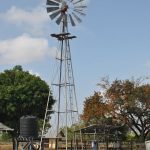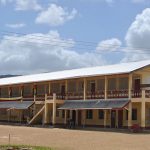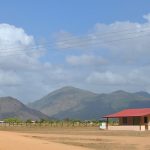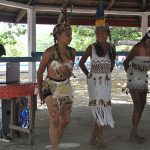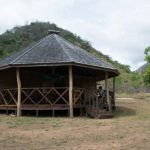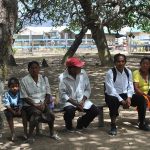An economic hub waiting to unleash itself
NESTLED in the centre of the Pakaraima Mountains, Karasabai is an indigenous village located in the North Rupununi Savannahs of Guyana. Its population now stands at approximately 1,500, surpassing its earlier count of 1,158 people, the majority of whom hail from the Macushi Tribe.
Tucked far away from the coastland, with no access to radio or television signals, telephone services and extremely limited internet access, villagers there live simple lives. On a small scale, they engage in cattle rearing and subsistence farming, and the surplus, if any, is sold. Importantly, they engage in the sale of cassareep, cassava bread, and farine
In January 2018, the villagers took a small but significant step into the Tourism Industry as a push to transform the economic landscape of Karasabai. The Kezeé Eco-Lodge was launched. Sitting at the ‘foot’ of a mountain near the Wee-Ye Creek, the eco-lodge provides a picture perfect view of the Pakaraima Mountains and the beauty of the rare golden parakeets. The Wee-Ye Creek, which got its name from a tree called Wee-Ye ( a Macushi word which means “Sun Tree”) provides an interesting story – it always runs and never dries, though not connected to any other larger stream, creek or river.
“Years ago there was a drought in Karasabai, all the creeks, ponds and rivers dried up and the only one that didn’t dry up was that creek. So, all the animals went to that creek to drink water until it rained again. It is believed that that particular tree supplied all the animals during the drought. So actually the tree is the main source of the water,” one of the villagers, Seon Kartright, explained.
THE LEGEND OF THE WEE-YE TREE
According to Kartright, it is more of a legend. “During the flood in the Noah days, that tree is the only one that didn’t drown because it was very, very tall. So when the flood had passed, well for sure all the plants, trees, fruit trees would die. So in order to have fruits again, that same tree contained all the fruits you could think about. So what they did is to cut down the tree in order to have the fruits for seedlings to re-plant,” he explained. The ‘legendary’ tree grew back but not to such great height but remains ‘a source of water’ to the creek. Tourists, he said, are always intrigued by the rich tradition of the Macushi people and the legends associated with Karasabai.
EMPLOYMENT OPPORTUNITIES
Kartright and Marlon Edwards are among the upcoming leaders of Karasabai with a passion for youth empowerment. They have been collaborating with the Ministry of Indigenous Peoples’ Affairs and the Department of Culture, Youth and Sport, to provide the younger generation of Karasabai with opportunities in the areas of education, culture, entrepreneurship and tourism among other critical areas.
While Karasabai has a great eco-tourism package to offer, Edwards believes that the establishment of a factory to produce by-products of cassava and other products on a large scale, would not only add to the growth of the village economy but provide much-needed employment to hundreds of the villagers there.
“It could process our produce because we produce a lot of cassava products, farine, cassava bread, cassareep, peanuts, cashew nuts and a lot of mangoes,” he said.
Using cassava as an example, Edwards said the villagers use the bitter cassava to make cassava bread for their personal use, while the cassareep is mostly sold to locals and the farine is sold to the Brazilians but on a small scale.
Kartright explained that using the Ireng River, which forms part of Guyana’s western border with Brazil and flowing through the valleys of the Pakaraima Mountains, the villagers cross over to Brazil with their farine for sale. “They sell it by the can and the can is 20 litres, but in Guyana, they sell it by the pound. Every can of farine is $5,000 or 60 Real in Brazil,” he explained.
With a factory in place, and a good marketing and advertising team, Kartright believes that villagers could significantly introduce their sale of farine to Brazil and introduce them to cassareep. Cassareep is not largely bought by the Brazilians. The peanuts, cashew nuts, and even mangoes can also be processed to export to Brazil and other countries.
THE NEED FOR DEVELOPMENT
But both Kartright and Edwards agreed that in order for this vision to materialise, Karasabai needs reliable sources of water and electricity. Currently, the village uses primarily solar power for the supply of electricity that is not at all times reliable. But Edwards said, there is a plan in place.
“As it relates to electrification of the village, we have a plan to repair a caterpillar generator that has not been functioning for a number of years,” Edwards noted.
Chief Executive Officer (CEO) of the Hinterland Electrification Company, Horace Williams said, that while the village’s electrification programme is under the control of the village council, the Public Infrastructure Ministry, through the Hinterland Electrification Company, will offer some assistance. He said he was recently informed of the dysfunctional generator and would have the fuel pump tested and repaired if necessary.
Edwards and Kartright had reached out to the company for assistance, last Wednesday. During that meeting, it was also brought to the attention of Williams that most of the solar panels used to supply the community buildings are also dysfunctional. He has committed to sending a team of technicians to Karasabai to conduct a survey and restore the systems.
With regards to water, the villagers use hand dug wells as their water source. In central Karasabai there are approximately 20 hand-dug wells being used by families.
“Those wells are not reliable because during the dry season it would run very low and the water becomes dirty which is not healthy,” Edwards explained. In the not- so-distant-past, a windmill pumped water into tanks and then into buildings but that is no longer working. Currently, a small percentage of the residents access tap water, but it is hoped, that this service would be extended to all residents.
The Guyana Water Incorporated (GWI) has committed to strengthening the village’s water supply system. Additionally, it is the hope of the villagers that the Guyana Telephone and Telegraph (GTT) and or Digicel Guyana would launch a tower in the area to provide cell service. Through the National Data Management Authority (NDMA), internet is provided with the primary school as the hub. “We have an internet hub there, but it is not reliable because of the electricity situation. So, for now, we are using a generator and it is normally turned on every Mondays, Wednesdays, and Fridays from 3 o’clock to about 5 o’clock, and everyone gathers around at the school just to use the internet,” Kartrigh said.
EDUCATION
Those issues aside, Edwards and Kartright said that Karasabai has both nursery and primary schools, with a secondary department, as well as a health centre.
According to the headteacher of Karasabai Primary School and the Secondary Department, Michelle George, her teachers would soon be exposed to professional training.
By using the internet, George said her students are now able to conduct their research, as well as the teachers.
The government has committed to building a secondary school in Karasabai in 2020. Currently, the secondary department is housed in the primary school.
Though all may not be well at the moment, Kartright and Edwards said that they are satisfied with the commitments made by the government to address those issues.



.jpg)




